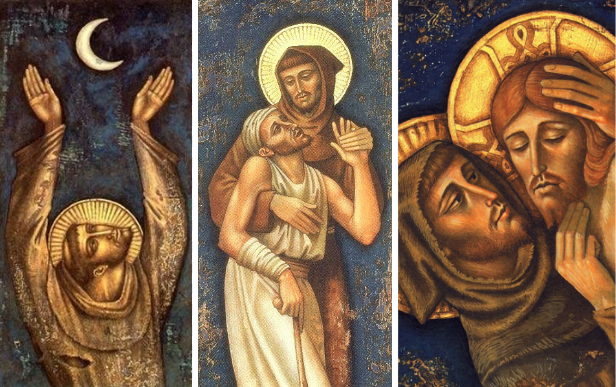Gallery of the Canticle by Piero Casentini

Español
Man and nature, universe and history: between the sun and the moon the artist Piero Casentini engages with the excellence of the Canticle of creatures, as a psalm of the testimony of St. Francis of Assisi, and interprets it by reconsidering the historical presences in Assisi by Cimabue and Giotto and Pietro Lorenzetti. For many years Casentini has been studying and realizing important experiences of sacred art precisely in the charisma of Poverello.
Man and nature, universe and history: between the sun and the moon the artist Piero Casentini engages with the excellence of the Canticle of creatures, as a psalm of the testimony of St. Francis of Assisi, and interprets it by reconsidering the historical presences in Assisi by Cimabue and Giotto and Pietro Lorenzetti. For many years Casentini has been studying and realizing important experiences of sacred art precisely in the charisma of Poverello.
The artist lives between Rome - where he was born in 1963 and graduated from the historic Academy of Fine Arts - and Assisi - where, among numerous interventions, he decorated the entrance to the Domus Pacis of Santa Maria degli Angeli - and Valmontone - where in the Convent of Sant'Angelo he admirably illustrated the Gospel of Jesus and the stories of S. Francesco and S. Antonio -. At Poggio Bustone he painted a perfect icon of San Francesco and the Cross. Continue reading after the advertisement
At Greccio, at the Shrine of the Crib, he explained very well, with tempera on the wall and poignant image, the Franciscan reality of the "table of the poor", and of Jesus the involving "Last Supper", whose theme then - by innovating its image - splendidly realized in the great work for the Refectory at the Convent of San Salvatore in Jerusalem. Of the latter, the Custos of the Holy Land p. Pierbattista Pizzaballa wrote: “Representing the Gospel, painting its places: Piero Casentini has the great gift of humbly placing himself at the service of this charism that he has received, and his works are a catechesis in images, just as the tradition of the Church has always proposed over the centuries, making art a privileged channel for the manifestation of faith ". Continue reading after advertisement
So in Jerusalem as in Assisi, here again at the Convent of San Damiano Casentini confirms the quality of his artistic research as an expression of the Franciscan charism: on the occasion of the 54th edition of the Feast of the Canticle, Sunday 16 September, his new art cycle dedicated to the Canticle of creatures. It is a cycle that surprises with its capable expressive force and the depth of theological thought.
The cycle is exhibited almost as if it were a film sequence, as if painting leads us to see Francesco move and meet us, as if to rethink the works of the great directors who have ventured on Francesco - like Rossellini and Zeffirelli, like Liliana Cavani -. Archbishop Carlo Chenis wrote that Casentini with his art offers us "Franciscan candor and realism"; and from the Canticle of the creatures the artist shows us the sun and the stars and the moon, the Earth and the fire and the water and the air, together with the images of Saint Francis embracing the dead Christ and allowing himself to be welcomed by an elderly paternal friar - thinking back to Lk 15, 11-32 -. Continue reading after advertisement
The painter reiterates that Francis of Assisi is alter Christus, and introduces us to the spirituality of Creation. Like "Laudes creaturarum", the Canticle painted by Casentini is a praise. The Franciscan artist paints because of the sanctissimus and the altissimus to confirm the immutabilis, the ineffabilis and therefore to be able to conform his painting to the achievement of the amabilis. It is a painting of contemplation, where the air and the earth show Saint Francis in meditation before the light of the night with the moon and the light of the day in the sun. While air and earth and sun and moon and stars express the vertical condition in composition, with fire and water there is an arching of the body of Francis that accompanies the element in question: as if that bending, that arching is to be understood as his being welcoming and involving us in the gift of life. The sequence of images thus traces a kind of via pulchritudinis.







Comments
Post a Comment